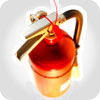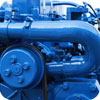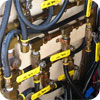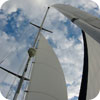Safety
We know safety is no accident. Our captains are highly trained and safety conscious sailors. We won't set out to sea without until we are satisfied of a vessel's seaworthiness. A boat which passes one of our inspections will easily pass a U.S. Coast Guard Safety Inspection. Here is a list of some of the things we inspect prior to getting underway to make sure your boat and our crew arrive safely.
The Hull
 We thoroughly inspect through-hull fittings and sea cocks for electrolysis and functionality and all hoses and clamps for cracks and leaks.
We prefer that the bottom is sufficiently clean when we arrive at the vessel so a reasonable cruising speed can be maintained.
We'll also inspect the keel bolts, rudder stock and steering gear.
We thoroughly inspect through-hull fittings and sea cocks for electrolysis and functionality and all hoses and clamps for cracks and leaks.
We prefer that the bottom is sufficiently clean when we arrive at the vessel so a reasonable cruising speed can be maintained.
We'll also inspect the keel bolts, rudder stock and steering gear.
Safety Equipment
 We inspect all flares (expiration dates and moisture under the caps) and other visual distress signals,
test sound signals (bells and whistles), test fume detectors on gasoline installations, check bilge pumps and piping,
filters and float switches, EPIRBs, VHF and SSB radios, fire extinguishers, first-aid kits, person-in-water (crew-overboard) equipment,
life rafts and lifesaving gear.
We prefer life rafts for trips which take us more than 20 miles offshore and an inflatable dinghy for all trips.
We inspect all flares (expiration dates and moisture under the caps) and other visual distress signals,
test sound signals (bells and whistles), test fume detectors on gasoline installations, check bilge pumps and piping,
filters and float switches, EPIRBs, VHF and SSB radios, fire extinguishers, first-aid kits, person-in-water (crew-overboard) equipment,
life rafts and lifesaving gear.
We prefer life rafts for trips which take us more than 20 miles offshore and an inflatable dinghy for all trips.
Engines
 Next it's off to the engine compartment, where we inspect hoses, belts and wiring.
We check and change the oil and the fuel filters as required per your maintenance log.
We also check fuel tanks for cracks and leaks, inspect shift/throttle control cables and linkages on both ends.
We inspect propellers and shafts and adjust the packing glands as needed.
Next it's off to the engine compartment, where we inspect hoses, belts and wiring.
We check and change the oil and the fuel filters as required per your maintenance log.
We also check fuel tanks for cracks and leaks, inspect shift/throttle control cables and linkages on both ends.
We inspect propellers and shafts and adjust the packing glands as needed.
Electrical and Plumbing
 Topping off and testing batteries, cleaning terminals as necessary, testing all lights, electronics and other circuits,
checking for loose wires and ensuring alternator and charging systems are performing properly is an important part of the inspection.
Checking marine sanitation devices—heads, holding tanks and their plumbing—cannot be overlooked. We make sure Y-Valves aren't leaking,
and that they are diverting waste into the holding tank—not overboard!
Topping off and testing batteries, cleaning terminals as necessary, testing all lights, electronics and other circuits,
checking for loose wires and ensuring alternator and charging systems are performing properly is an important part of the inspection.
Checking marine sanitation devices—heads, holding tanks and their plumbing—cannot be overlooked. We make sure Y-Valves aren't leaking,
and that they are diverting waste into the holding tank—not overboard!
Rigging
 It is very important to inspect all standing rigging including spars, shrouds, stays, swages or mechanical terminals (i.e. StaLok or Norseman),
turnbuckles and chainplates. Anyone who has ever experienced a chainplate, shroud or any standing rigging failure knows how scary it can be.
We also inspect the running rigging—halyards, sheets, guys and spare lines—and deck hardware including roller furling units,
boom vang, winches, turning blocks, sheaves and deck organizers to make sure they turn freely and operate properly.
Docklines and anchor rodes are inspected. Anchors are secured before heading to sea.
It is very important to inspect all standing rigging including spars, shrouds, stays, swages or mechanical terminals (i.e. StaLok or Norseman),
turnbuckles and chainplates. Anyone who has ever experienced a chainplate, shroud or any standing rigging failure knows how scary it can be.
We also inspect the running rigging—halyards, sheets, guys and spare lines—and deck hardware including roller furling units,
boom vang, winches, turning blocks, sheaves and deck organizers to make sure they turn freely and operate properly.
Docklines and anchor rodes are inspected. Anchors are secured before heading to sea.